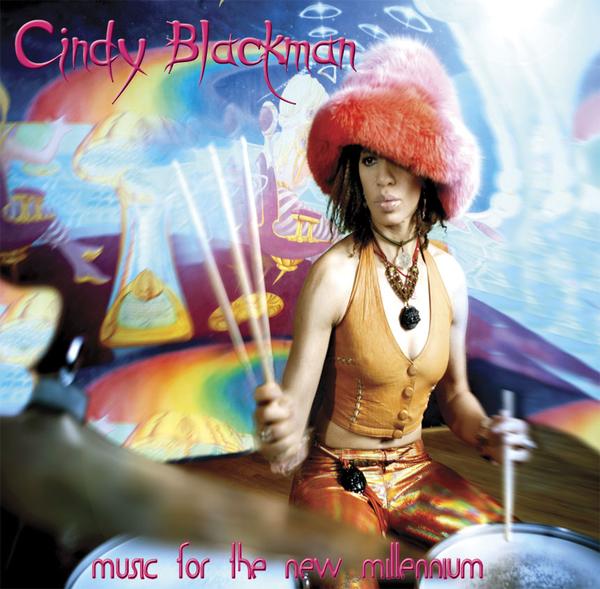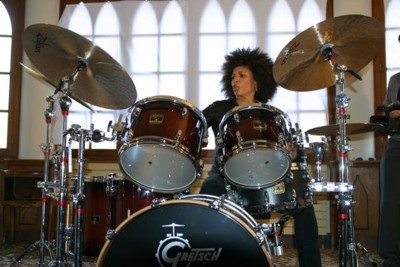 Cindy
Blackman From Art Blakey to Lenny Kravitz
Cindy
Blackman From Art Blakey to Lenny Kravitz
 Cindy
Blackman From Art Blakey to Lenny Kravitz
Cindy
Blackman From Art Blakey to Lenny Kravitz
Interview by Joe Montague
 There
exists a misguided notion among some music fans that the words rock musician and
wild life are synonymous, however as Riveting Riffs discovered in our
conversation with prolific rock / jazz drummer Cindy Blackman, that truly is a
misperception, for the congenial, articulate Blackman is very family oriented.
In fact, Blackman who toured as Lenny Kravitz’s drummer for ten years, before
embarking on a solo career as a jazz drummer, credits those deep family roots,
for a lot of her early musical influences, and dedicated her current album,
Music
For The New Millennium, to her paternal
grandmother. Do
not misunderstand what we are saying here, Blackman can be as dynamic and loud
on the drum kit when she is keeping the beat, for songs like Kravitz’s “Let Love
Rule,” as any rocker you have ever heard.
There is however, far more to this superb
musician than what the casual listener may assume.
There
exists a misguided notion among some music fans that the words rock musician and
wild life are synonymous, however as Riveting Riffs discovered in our
conversation with prolific rock / jazz drummer Cindy Blackman, that truly is a
misperception, for the congenial, articulate Blackman is very family oriented.
In fact, Blackman who toured as Lenny Kravitz’s drummer for ten years, before
embarking on a solo career as a jazz drummer, credits those deep family roots,
for a lot of her early musical influences, and dedicated her current album,
Music
For The New Millennium, to her paternal
grandmother. Do
not misunderstand what we are saying here, Blackman can be as dynamic and loud
on the drum kit when she is keeping the beat, for songs like Kravitz’s “Let Love
Rule,” as any rocker you have ever heard.
There is however, far more to this superb
musician than what the casual listener may assume.
The crafting of Blackman’s
keen sense of musicianship began when she was a child, and in part, under the
watchful eye of her maternal grandmother, who was a classical pianist. “She
didn’t like the damper or sustain pedal on a piano, because she felt that if you
wanted to make a note ring, you should do it with your touch, and if you wanted
to dampen a note, you should do that with your touch as well. That always stayed
in my head, and when I got to a certain level of proficiency with an instrument,
I completely understood what she meant. That really got me to thinking about my
touch, how I hit the instrument and the sound that I get out of the instrument.
Those two people were really important to my
growth and the path that I got on very early in my life,” says Blackman.
The second disc of Blackman’s
current double CD
Music For The New Millennium,
contains two songs, “Insight (From My Mother),” and “Insight (From My Father),”
which speak to her family centric values, and pay tribute to the influence that
each of her parents had on her life.
“(The song) “Insight,” is given different treatments
throughout the entire record. It is recorded on both CDs (“Insight (Past
Wisdom),” “Insight (Right Now),” and “Insight (The Future),” and each one
reflects a different period of my learning, the different things that I am
experiencing, and the things that I have learned from different people. “Insight
(From My Mother),” is like my mother, who is very strong, but also very soft.
She is a beautiful person inside and out. My mom is pretty special, and the song
reflects what I get from her. “Insight (From My Father),” is more hard hitting
and driving. It is more like my dad. It is more the strong guy, the heavy hitter
kind of guy,” says Blackman, noting the song reflects the jazz musical
influences of her father.
As for the other treatments
of “Insight,” which appear on
Music For The New Millennium,
Blackman says that they represent her maturing, both a person and an artist.
“The different
Insights are
woven together throughout the record, and there is a different feel and approach
to the way that we play them. They are the very same song, the very same form,
but they feel very different. That is a very noticeable thread (that connects
them).”
“Even the songs that are not my compositions, but are J.
Dee’s compositions, fit in a certain way with all of the rest. They are like big
pieces of a puzzle that are put together, and they make a collage,” says
Blackman.
Blackman’s ability to transcend
genres is not surprising considering the eclectic musical flavors that abounded
within her family. For instance, when she was a small child, Blackman’s mother
took her to the 
Blackman’s older sister Anasa
also had a profound effect on her younger sibling’s musical development.
Despite dealing with the effects of a heavy
cold, at the time of our conversation, Blackman came to life and was practically
bubbling while recalling Anasa’s influence. “She had a fantastic record
collection. She had everything in that collection, including the Beatles, Sly
and the Family Stone, James Brown, Miles Davis, John Coltrane, Chaka Khan,
Earth, Wind & Fire and Betty Davis. She had just about everybody in rock, except
unfortunately Led Zeppelin. I was able to listen to all kinds of music while
growing up. Rock was not a stretch for me at all, because I grew up listening to
that, and playing it. For a while after she (her sister) moved out of the house,
she left her record collection with us. I inherited her room, which meant that I
also inherited her music collection. I was able to listen to those records every
day. I was certainly lucky in that respect.”
Even though familial ties and
influences infuse Cindy Blackman’s music, it was great bebop jazz drummer Art
Blakey who became a mentor to her. “He had such a great and beautiful spirit.
When I first came to
“I really loved Art Blakey so
much, and I really miss his energy. When he passed away, there was a big whole
in the scene. For so many years, all the musicians would flock to
While speaking with Cindy Blackman you become very aware
that you are in the presence of someone who has truly mastered her craft. She is
to the drum kit, what Eric Clapton is to the guitar, John Coltrane and Charlie
Parker were to the saxophone and Stanley Clarke is to the bass. She is an
innovator, not content to settle, but to continually raise the bar, and push the
envelope. It is that desire for continually creating a new standard of
excellence that always allows the truly great artists to rise above the rest.
Blackman compares the
different approaches that she takes to music, dependent on the style that she is
playing, “The goal for me is to be able to make the music change and grow, and
to be able to converse with the other musicians. You want to bring the music
alive with the textures and colors that you add (when playing jazz), whereas in
a rock situation you have to keep that backbeat happening, keep it dancing, and
feeling good the whole time. If I am playing jazz, I want to have that music
feeling great, but now I can expand and add other ideas. A common goal for me
with all music is that it should feel good.
In jazz music, I expand on top of that
feeling.”
As one would expect, Blackman’s technique varies
depending on the type of music that she is playing. “For sure it is a totally
different headspace. When I am playing with Lenny, it is completely different,
because the whole concepts and the goals of the band are different. The way that
I hit the drums is different, because (she chuckles) I hit them really hard.
Although I hit them hard, I need to be able to get a sound of the kit without
choking it. You need to know how to match the physical strength that is
(required), with the need to still get a good sound of your instrument. When I
am playing in more of a creative situation (referring to jazz), I have more of a
love affair with texture, and with a variety of soft and strong playing. All of
the subtleties and nuances are used. I play little things here and there, some
of which you may pick up, because they are audible, and others are just for the
feel.”
Blackman compares rock drummers with their jazz
counterparts, “Some drummers don’t go back and forth. Some drummers, who play
rock, don’t have the slightest idea of what it takes to be a jazz drummer, and
some jazz drummers don’t have the slightest idea of what it takes to be a rock
drummer. I will say however, that because of the requirements for playing jazz,
a jazz drummer who wants to play rock, could probably play rock easier, than a
rock drummer who wants to play jazz. When you play jazz drums, you have to have
more facility, and there is more required of you. There are a lot of things that
you need to know (in terms of time signatures and formations). When you play
rock drums you can play it in a three-note style or play it as 2/4, (she
imitates the sound of her sticks hitting the drums and cymbals). You will work
(as a rock drummer), make a ton of money, and you do not need to know other
things, but in jazz there is a lot more required of you as a drummer.”
Cindy Blackman has become a master drummer in both the
world of jazz and rock music, but if you were to ask her, I bet she would say
she still has much to learn, and so many more colors and textures that she wants
to explore. For young drummers, she could not be a more perfect role model, as
someone who continually strives for excellence, while remaining respectful of
her past, and those who have helped her attain the career that she enjoys today.
When you talk to her, she doesn’t dwell on her accomplishments, but instead
remains focused on the music. She is fun and sincere. If you are an aspiring
drummer and you are looking for a mentor, look no further, for Cindy Blackman is
the only name that you need to know.